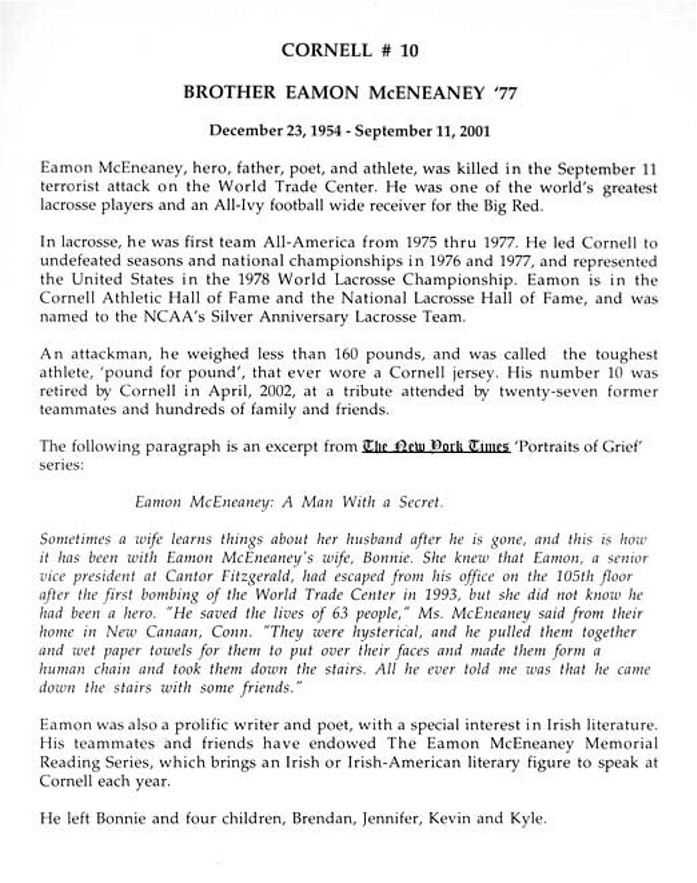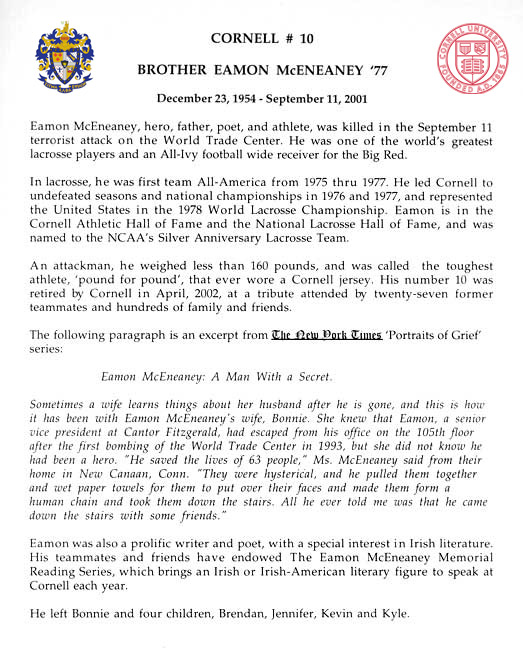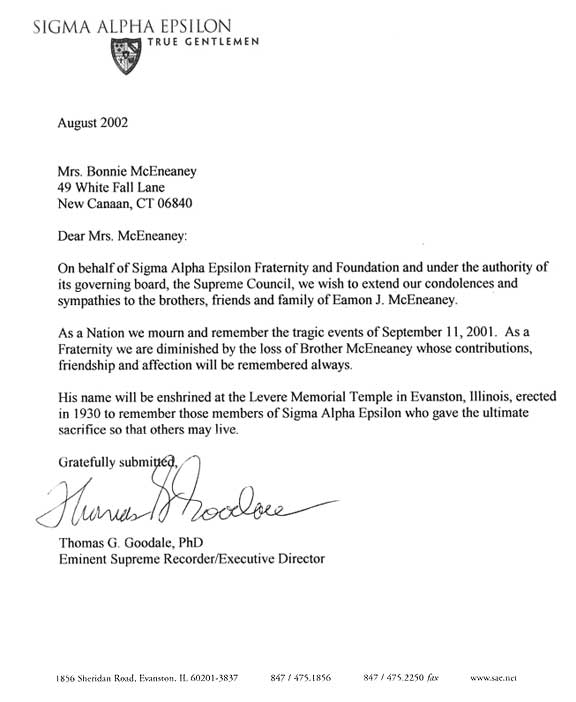Eamon McEneaney’s (’77) name on panel #57 around the edge of the reflecting pool at the 9/11 Memorial in New York City. In this particular instance, the names are not alphabetical as they are at the museum memorial locations, but rather are grouped with his associates at Cantor Fitzgerald.
May/June 2012 issue of Cornell Magazine
Lax Legend: Former lacrosse star Eamon McEneaney ’77 was named the second recipient of the Tewaaraton Legend Award, which is presented annually to a former college lacrosse player who finished his career before the Tewaaraton Award was established in 2001. McEneaney was a three-time All-American and helped lead Cornell to two national titles and back-to-back undefeated seasons in 1976 and 1977. His wife, Bonnie McEneaney, MPS ’78, will accept the award on May 31, 2012. McEneaney was killed in the 2001 attack on the World Trade Center.
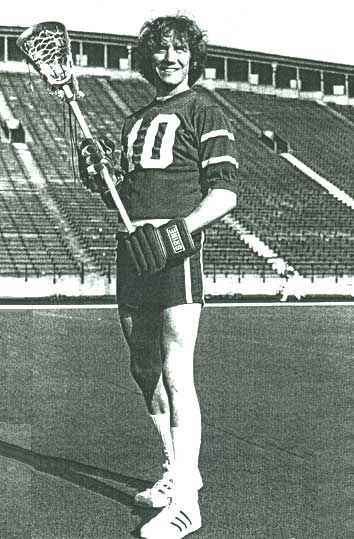 Eamon McEneaney, hero, father, poet, and athlete, was killed in the September 11 terrorist attack on the World Trade Center. He was one of the world’s greatest lacrosse players and an All-Ivy football wide receiver for the Big Red.
Eamon McEneaney, hero, father, poet, and athlete, was killed in the September 11 terrorist attack on the World Trade Center. He was one of the world’s greatest lacrosse players and an All-Ivy football wide receiver for the Big Red.
In lacrosse, he was first team All-America from 1975 thru 1977. He led Cornell to undefeated seasons and national championships in 1976 and 1977, and represented the United States in the 1978 World Lacrosse Championship. Eamon is in the Cornell Athletic Hall of Fame and the National Lacrosse Hall of Fame, and was named to the NCAA’s Silver Anniversary Lacrosse Team.
An attackman, he weighed less than 160 pounds, and was called the toughest athlete, “pound for pound,” that ever wore a Cornell jersey. His number 10 was retired by Cornell in April, 2002, at a tribute attended by 27 former teammates and hundreds of family and friends.
The following is an excerpt from The New York Times “Portraits of Grief” series:
Eamon McEneaney: A Man With a Secret.
Sometimes a wife learns things about her husband after he is gone, and this is how it has been with Eamon McEneaney’s wife, Bonnie. She knew that Eamon, a senior vice president at Cantor Fitzgerald, had escaped from his office on the 105th floor after the first bombing of the World Trade Center in 1993, but she did not know he had been a hero.
“He saved the lives of 63 people,” Ms. McEneaney said from their home in New Canaan, Connecticut. “They were hysterical, and he pulled them together and wet paper towels for them to put over their faces and made them form a human chain and took them down the stairs. All he ever told me was that he came down the stairs with some friends.”
Eamon was also a prolific writer and poet, with a special interest in Irish literature. His teammates and friends have endowed The Eamon McEneaney Memorial Reading Series, which brings an Irish or Irish-American literary figure to speak at Cornell each year. He left Bonnie and four children, Brendan, Jennifer, Kevin and Kyle.
On Sept. 11’s Anniversary, Lacrosse Hall of Famer Eamon McEneaney is Remembered for his Spirit
The following article, by sports columnist Dave D’Alessandro of the Newark Star-Ledger, was originally posted September 11, 2011, on NJ.com; courtesy of Bonnie McEneaney.
Someone once remarked that Eamon McEneaney played lacrosse like Magic Johnson played basketball.
He was special, they said, in that he could see things that nobody else could see.
And that included seeing his own death, in the days before that terrible morning 10 years ago.
His qualities were evident from his high school days on Long Island, actually–long before he was credited with helping transform a sport that was purely JV box office into one that lured crowds of 15,000 and ABC Wide World of Sports.
Some say he lived the way he played. On the field, he was unconquerable, gifted with a freakish athleticism, the kind of guy who could do anything better than anyone else you knew. At 5-10, 150, he could dunk a basketball over his head, off a 180-degree spin. He was an all-Ivy League receiver–though he originally made the team as a walk-on. And after college, the Jets offered him a job on their taxi squad as a punt returner. He chose bond trading instead, and rose to senior VP with Cantor Fitzgerald.
Off the field? Put it this way: His wife, Bonnie, first met him at the Nines, a popular bar on College Avenue in Ithaca. He was wearing only a towel and sneakers. He had just come from a streaking rally.
But McEneaney’s greatest fame came on the lacrosse field, where he is still regarded as the greatest player of his generation. What he accomplished at Cornell is still celebrated, 10 years after his death and nearly 30 years since his induction into the National Lacrosse Hall of Fame.
“Eamon had a quality that was hard to describe,” said his coach, Richie Moran, a Hall of Famer himself. “His quickness was astonishing. I haven’t seen anything like it since. But he was just a very dynamic individual, on and off the field.”
His position was attackman. He was more of a feeder than a scorer, because in this frenzied and barbaric sport, he could sense where everyone would be–even if it looks like 20 guys running 110-yard wind sprints and trading jabs to the ribs with sticks for 60 minutes. So this is what separated McEneaney from the rest: He was headstrong and high-maintenance as a college kid, but he had an intuitive quality when surrounded by chaos.
We thought of him when the commemorations started up. Typically, we’re not fans of 9/11 memorials at sporting events. Sports has nothing to do with what happened in Manhattan, or at the Pentagon, or in Shanksville. Yet as long as they can book the Blue Angels to soar over the Tostitos Fiesta Bowl, sports and valor and patriotism will always share a stage, even when it’s contrived and hyperbolized.
But so many of these values seemed to intersect in the life of McEneaney, who was 46 and the father of four when he died.
For starters, he was an authentic hero. During the terrorist bombing of the World Trade Center in ’93, he was the fire captain of the 105th floor, the guy who kept them calm and orchestrated the human chain that led his fellow Cantor employees through thick black smoke to safety.
“I found out that he saved the lives of 63 people that day,” Bonnie said. “All he told me later was that he ‘took the stairs with some friends.’
“But that experience stayed with him. He really didn’t want to be working there. But he loved the guys he worked with on the 105th floor. He couldn’t bring himself to leave them.”
He often spoke of retiring in 2002 to concentrate on his writing. Poetry, mostly. “A football player who wrote poetry,” his brother, Kevin, said with a chuckle. “You ask me how Eamon’s unique, there’s your answer.”
But Bonnie was right: McEneaney was undergoing changes that even he couldn’t understand. In the weeks before 9/11, he had premonitions. It was common knowledge among those who knew him. His brother learned about it Sept. 2, during a Labor Day function: “He always thought they would be a target again,” Kevin McEneaney said. “But that week before, he was talking in some very macabre ways about how the time was coming.”
“The talk increased with intensity, and I started to worry that he was falling into a depression,” Bonnie said. “He spoke of where he would lead his people this time–down the stairs, or up to the roof. And the week before he died, he said to me, “I just want you to know that I can handle my death now.”
This was not a Marine in Kabul sharing his fear that he might not make it home. This was a guy who worked in an office building, sensing that something unfathomable would happen one week before he became part of the heartbreaking calculus of death.
In the end, he and 657 other Cantor employees were lost because there was no escape from the impact zone near the 105th floor of Tower One. It took five days to find his remains. A decade later, Bonnie said, “You live with it every day. If you lost someone there, that day never leaves you.”
Yet Eamon stays with her in other ways, which is a striking epilogue to his story. To this day, she senses his presence–tangibly, she asserts. A timely gust of wind as she calls his name. The emergence of a blue heron in the snow at his gravesite when she visits. Paranormal? She prefers the term “spiritual.” It inspired her to interview 200 people from the 9/11 community and turn their stories into a book (“Messages: Signs, Visits and Premonitions from Loved Ones Lost on 9/11”) and a documentary that aired last night on the Biography Channel.
As Kevin put it, “Eamon was deeply spiritual. If someone can figure out how to get a message back, it would be Eamon.”
Whether you believe these stories hardly matters. It brings comfort to the bereaved. And if you dismiss these experiences as coincidences, we’ll toss this one into the discussion: The number of Jersey men we lost that day who had a connection to the sport of lacrosse is both curious and unsettling. There were at least 12, from navy Capt. Bob Dolan, an East Hanover native who died at the Pentagon, to John Schroeder, who won an NCAA title with Princeton.
This list stretches quickly, like a trail of tears, if you look throughout the region. It only starts with Eamon McEneaney.
“I still see him on the team bus, scribbling his poems on the back of a brown paper bag,” said Moran, who won back-to-back NCAA titles with McEneaney in ’76 and ’77. “And what a player. He had that incredible vision, but a bigger heart. That’s what stays with you, if you were lucky enough to know him.”
McEneaney shares stories of 9/11 victims’ loved ones
By Daniel Aloi
From the Cornell Chronicle, September 21, 2010
Bonnie McEneaney, MPS ’78, whose husband, Eamon McEneaney ’77, died Sept. 11, 2001, in the attack on the World Trade Center, shared her paranormal experiences and those of others who lost friends and family that day, in a reading from her book, “Messages: Signs, Visits, and Premonitions From Loved Ones Lost on 9/11,” Sept. 16 in Hollis E. Cornell Auditorium.
Her husband was a member of the two-time NCAA Championship-winning Big Red lacrosse team, a father of four, a poet “and a prankster,” his widow said. They met at The Nines in Collegetown when she commented on his outfit, a towel, after he had participated in a streaking rally on campus.
“He loved Cornell. Not as much as he loved Ireland, but he did love Cornell,” she said.
Eamon worked in an investment firm on the 105th floor of the North Tower, and had helped 66 people to safety in the 1993 World Trade Center bombing. In the weeks before the 2001 attack, he had spoken more than once of something about to happen to him, Bonnie McEneaney said.
These portents of foreboding on her husband’s part, and hearing of many other instances of spiritual, paranormal and other signs among surviving friends and family members of 9/11 victims, prompted her to write the book, she said.
“Love is the central, common denominator of these stories, and it’s what connects us,” she said, adding that the project took five years, in which she conducted more than 200 interviews. She also edited a posthumous volume of Eamon’s poetry, “A Bend in the Road.”
“This book [‘Messages’] is, in truth, a paean to love and connection, and the great commitment that love begets us,” said Ken McClane, professor of English, in his introduction of Bonnie McEneaney.
The event was sponsored by the Department of English and the Creative Writing Program Fall Reading Series. Upcoming fiction writers and poets in the series include Lydia Davis, Sept. 30; Carl Phillips, Oct. 14; and John Murillo, Nov. 4. Information: http://www.arts.cornell.edu/english/creative/.
Hillcrest Tributes to Eamon McEneaney
The following two items are photos of framed plaques on our tribute wall at Hillcrest. Click on the images to zoom in and view the full size.
A Tribute to Brother Eamon McEneaney ’77
By Kathleen Bolton
From The Cornell Spirit, March 2005
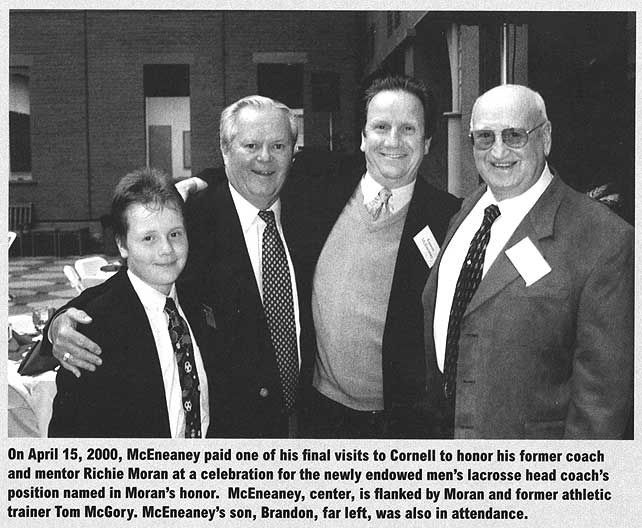
In 1972, Eamon McEneaney was the most sought-after collegiate lacrosse recruit in the country, but head coach Richie Moran was not daunted. He would use all his considerable powers of Irish persuasion to convince McEneaney to play lacrosse for the Big Red.
McEneaney, a hotshot high school athlete from Elmont, New York, was entertaining offers from Big Ten colleges and universities, all willing to give the talented prospect full scholarships — offers that an Ivy League university, with its emphasis on academics over athletics, could not match.
But Moran was not without some weapons in his arsenal. Already a highly regarded coach in the collegiate lacrosse world, Moran also happened to know McEneaney’s high school lacrosse coach, Bill Ritch, who fostered McEneaney’s talents in football, basketball, and lacrosse at Sewanhaka High School. And he intended to utilize that connection to its fullest.
“Eamon was a curly-haired leprechaun in those days,” Moran said. “I had some doubts that he could come to Cornell; academically and financially there were concerns.” But Ritch praised Cornell to McEneaney, causing him to listen more attentively to Moran when he came on recruiting trips to the high school. Moran suggested coursework that could beef up McEneaney’s academic record. He also persuaded McEneaney to work in a visit to Cornell among his long list of visits to other universities. To Moran’s delight, McEneaney agreed.
They worked out the details by phone. Moran put together an exhaustive itinerary for the highly sought after recruit, with a carefully planned schedule that would show the university and the lacrosse program in its best light: visits to prestigious professors, meals at the Statler Hotel, supervised fun in Collegetown, hard-to-get tickets to men’s ice hockey. McEneaney was to be given the redcarpet treatment.
So it was with great surprise that Moran received a phone call at home from campus the weekend before McEneaney was scheduled to visit. “I had just sat down to dinner,” Moran recalls, “when I got a call from Eamon saying he was at the lacrosse office, and asking where everyone was.” Horrified, Moran listened to McEneaney tell him that he traveled to Ithaca alone by bus, arriving at the downtown bus station where he proceeded to walk up the steep incline to the university, asking for directions at the top of each hill.
Panicked, Moran quickly called players Jay Gallagher ’74 and Bruce Arena ’73 with orders to find McEneaney, take him to dinner at the Statler, and then to a hockey game. Meanwhile Moran made a few phone calls to cobble together some sort of last-minute itinerary that would impress the recruit. He managed to set up a meeting with Dr. Leonard Feddema, then dean of the College of Agriculture and Life Sciences, a meeting that would change the course of McEneaney’s future.
For McEneaney, despite his impetuous nature, had made it a point to bring his writing portfolio with him, which he shared with Dr. Feddema. At the end of the meeting, Feddema was convinced that McEneaney was special, a blue-collar student-athlete whose force of personality would overcome any lack of academic skills, and told Moran so. Moran began to think that he now had a real chance to bring McEneaney to Cornell.
Moran took the young recruit to all the Cornell highlights: Sage Chapel, the libraries, the scenic overlooks. McEneaney seemed suitably impressed. Moran then handed him back to Gallagher and Arena to enjoy an evening’s social event at the Sigma Alpha Epsilon fraternity, after which they were to put the 17-year-old back on the bus to Long Island.
One week later, Moran received a call from McEneaney’s high school guidance counselor, commending Moran on the great visit he had arranged for Eamon, who had arrived back at Sewanhaka High School full of enthusiasm for Cornell. However, the counselor told Moran, it was a pity that the pickup basketball game he had arranged for the players ended in seven stitches to McEneaney’s eyebrow from an errant elbow.
Moran, astonished, immediately called Gallagher and Arena to get the details. What emerged was troubling. The “social event” at the SAE fraternity was a party with a live band. McEneaney, who loved to dance, was grooving with the girlfriend of one of the frat brothers who took exception and landed a vicious blow to the teenager’s brow, causing a melee in the frat house. Concerned, Moran called McEneaney, certain that his hard work wooing the talented athlete was for naught.
“All he kept telling me was that he wanted to come to Cornell,” Moran said. “It was the greatest place in the world to him.”
“Then you’ll have to improve on your boxing technique,” Moran told him, finally leaving the loquacious Irish kid at a loss for words.
Addendum to “Coach Moran remembers Eamon”:
Eamon joined SAE and worked at the house in exchange for free room and board. After his tragic death, it was learned that SAE National had no record of his membership. However, his pledge brothers confirmed that he had been initiated, and the Fraternity sent an SAE pin and certificate of membership to his widow in 2002. An accompanying letter said: “His name will be enshrined at the Levere Memorial Temple in Evanston, Illinois, erected in 1930 to remember those members of Sigma Alpha Epsilon who gave the ultimate sacrifice so that others may live.”
Coach Moran believes that his SAE membership was not recorded and no pin issued in 1974 because he was unable to pay the initiation fee.
Remembering Eamon McEneaney: Cornell Lacrosse Legend With a Heart of Gold
By Barbara O’Neil Mingle
From The Cornell Spirit, March 2005
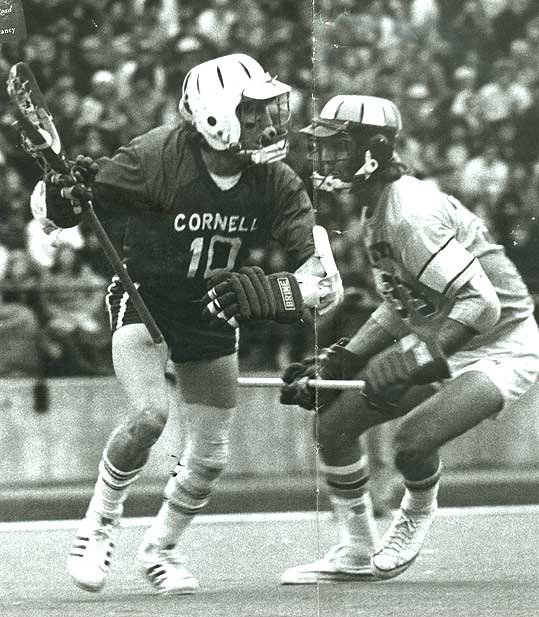 Special tribute was paid to Cornell lacrosse legend Eamon McEneaney ’77 following the men’s lacrosse team’s final home game of the season on April 27. Eamon, a former vice president at Cantor Fitzgerald, was killed in the September 11 terrorist attacks on the World Trade Center.
Special tribute was paid to Cornell lacrosse legend Eamon McEneaney ’77 following the men’s lacrosse team’s final home game of the season on April 27. Eamon, a former vice president at Cantor Fitzgerald, was killed in the September 11 terrorist attacks on the World Trade Center.
His death brought heartache to innumerable people, most especially his wife, Bonnie, his children, Brendan, Jennifer, Kevin and Kyle, and his father, Ed.
Celebration trumped grief, however, as the prevailing sentiment of the day, as 250 family and friends, some having traveled from as far away as London and Hawaii, gathered in Ithaca to pay homage to the lacrosse warrior with the heart of a poet.
Twenty-seven former teammates, many of whom brought their families, wore red T-shirts imprinted with Eamon’s number 10, supplied by former lacrosse player Joe Taylor ’80. They listened with rapt attention to their former coach Richie Moran, as he related anecdotes of their beloved teammate’s competitive spirit and generous heart before formally announcing the retirement of Eamon’s number 10.
Cornell Hall of Famer Mike French ’76, whose pairing with Eamon constituted what many believe was the best attacking duo ever to play lacrosse, recalled happier days on Schoellkopf Field in the mid-’70s. “We laughed. We didn’t have a care in the world. We were invincible and Eamon was the heart and soul of our team-our spirit,” said French, who spearheaded the effort to organize the memorial event” His devotion to family, friends, teammates was unconditional and unparalleled. It is what I will remember most about him.”
“A superstar of lacrosse,” is how Director of Athletics Andy Noel described the former three-time All-American who led-his team to national championships and undefeated seasons in 1976 and 1977. “He was an electrifying athlete who elevated all those around him,” said Noel. “In my first year coaching wrestling at Cornell I experienced the magic that was Eamon. I realized excellence could be achieved at Cornell and I raised my goals.”
Exhibiting uncommon strength and grace, Bonnie McEneaney spoke movingly of her husband and suggested that he sacrifice of his life and all the other victims of September 11 may have, in the long run, saved millions of lives by having roused our country to lead a global campaign against terrorism.
Bonnie also stressed the importance of making the most of every day. “Every hour, every minute, every second is a precious gift. Don’t put off too long those things you want to do. Make sure your priorities are correct. Every single day, celebrate life.”
Daughter Jennifer, age 9, and son Kevin, age 6, gave tangible proof that the spirit of their father, who enjoyed writing poetry, lives on. Tender words about their father were woven into poetry by Jennifer and into a prayer by Kevin and recited before the misty-eyed audience.
“Love is the strongest force that lives,” said Bonnie. To witness the outpouring of emotion elicited by her husband’s untimely death, was to conclude that Eamon’s tremendous capacity for love rendered him invincible after all.
McEneaney’s poems now available
Lacrosse great and 9/11 victim has work published posthumously
Cornell University Library press announced the publication of A Bend in the Road, poems by Eamon J. McEneaney ’77, in December 2004.
McEneaney, legendary lacrosse player for the Big Red, died when the World Trade Center collapsed on September 11, 2001. The poems are a collection of McEneaney’s work, written over his lifetime, and found after his death by his widow, Bonnie McEneaney.
Anyone who met McEneaney would be treated to a jovial man who loved life. But there was a dark side to McEneaney as well, one that manifested in his poetry and fiction. This was also coupled with an eerie belief that his life would be a short one. “Eamon’s poetry illustrates the incredible contrasts in his personality,” Bonnie McEneaney said. “He didn’t hesitate to explore that darkness.”
Premonitions of death suffuse his work, and in his poems McEneaney examines the connections between life, death and the spiritual web that binds them. Bonnie is finding that the elderly and terminally ill are drawing comfort in the poems, because they do not shy away from uncomfortable topics, such as speculating on the afterlife and preparing one’s self for death.
“What Eamon’s poems suggest is that one can be one of the greatest lacrosse players in the history of the game and also write poems of supreme invention, lyricism, and trenchancy,” says Professor Kenneth McClane, W.E.B. DuBois Professor of Literature. “Cornell is a magnificent school because one can be a great athlete and a wonderful poet, the two passions complementing each other, like fire and air. Eamon proves, and oh so powerfully, that the human heart blesses and celebrates.”
“I’m still amazed by this whole experience,” Bonnie says of the thread that McEneaney’s book of poems has woven around her in the aftermath his death. “Touch points connecting Eamon’s life to others are being revealed to me on a daily basis.”
Cornell NCAA Champ In Lacrosse; Upsets Maryland 16-13
By Steve Klein ’77
From the NY Alpha News, July 1976
The Big Red lacrosse team brought an NCAA championship back to Cornell as it upset defending champion Maryland 16-13 in two overtime periods on May 29. The triumph in the tournament final at Brown University, gave Coach Richie Moran’s squad a final slate of 16-0 along with the national title, the second for the Red since the post season tourney was started in 1971.
Approximately 12,000 spectators were on hand in Providence for the thrilling encounter, which marked the first time the game of lacrosse drew national television. Included in the crowd were a number of SAE actives and graduates. Among the alumni were former Cornell goalie Joe D’Amelio. ’75 and recent Eminent Archon Kenny “Runt” Steele. As with many other activities at Cornell, members at Hillcrest played a significant role in the accomplishments on the field.
EAMON McENEANEY, an all-American selection for the second straight year, broke an all time university career assist record midway through the season as he went on to register 61. The junior attackman now has 126 with a year of eligibility remaining. Voted the outstanding attackman of the country as a sophomore, Eamon’s ability as a feeder paved the way for teammate Mike French to break all NCAA scoring marks.
Although not on the field very often, BRIAN LASDA played a crucial role in the Red success story as a face-off specialist. The stocky midfielder from Tully, N.Y., had his best outing in the important mid-season clash with perennially tough Johns Hopkins. Frequently referred to as “Moose,” the former football star muscled his way to over two-thirds of the face-offs against the Blue Jays and received recognition in Sports Illustrated.
Perhaps Brian had his most memorable moment of the season when he scored his first career goal in the quarterfinal 14-0 win over Washington & Lee. During the last few minutes Lasda had the rare opportunity to play offense while Moran was pressing for an extremely rare shut-out. When he got near the goal Brian explained, “I saw the goalie and aimed the ball right at him, because I knew I couldn’t hit him.”
DAVE BRAY, a member of the second midfield unit, played consistently tough throughout the campaign and was a solid defensive player. Dave provided the fans with a few eye openers with his wind-up shots from the outside. The Animal Science major scored four goals and added the same number of assists.
Another brother at Hillcrest, VINCENT SHANLEY, was a defenseman on the undefeated squad. Vince saw limited action as a sophomore this spring but was superb when called on in man-down situations. Shanley came to Cornell two years ago and was a standout on the freshman team. After taking a year off, it took Vince a while to catch up on the field, but by his progress he is sure to play a big role in next season’s march.
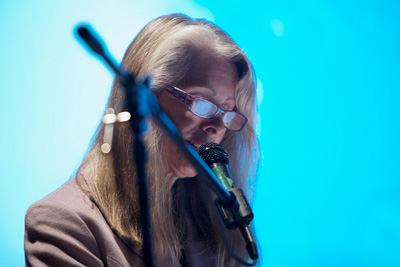 Bonnie McEneaney, MPS ’78, whose husband, Eamon McEneaney ’77, died Sept. 11, 2001, in the attack on the World Trade Center, shared her paranormal experiences and those of others who lost friends and family that day, in a reading from her book, “Messages: Signs, Visits, and Premonitions From Loved Ones Lost on 9/11,” Sept. 16 in Hollis E. Cornell Auditorium.
Bonnie McEneaney, MPS ’78, whose husband, Eamon McEneaney ’77, died Sept. 11, 2001, in the attack on the World Trade Center, shared her paranormal experiences and those of others who lost friends and family that day, in a reading from her book, “Messages: Signs, Visits, and Premonitions From Loved Ones Lost on 9/11,” Sept. 16 in Hollis E. Cornell Auditorium.
View the full story at the Cornell Chronicle site. Also, next time you visit Cornell, there is a memorial to Eamon in the library that all should see when at Hillcrest.
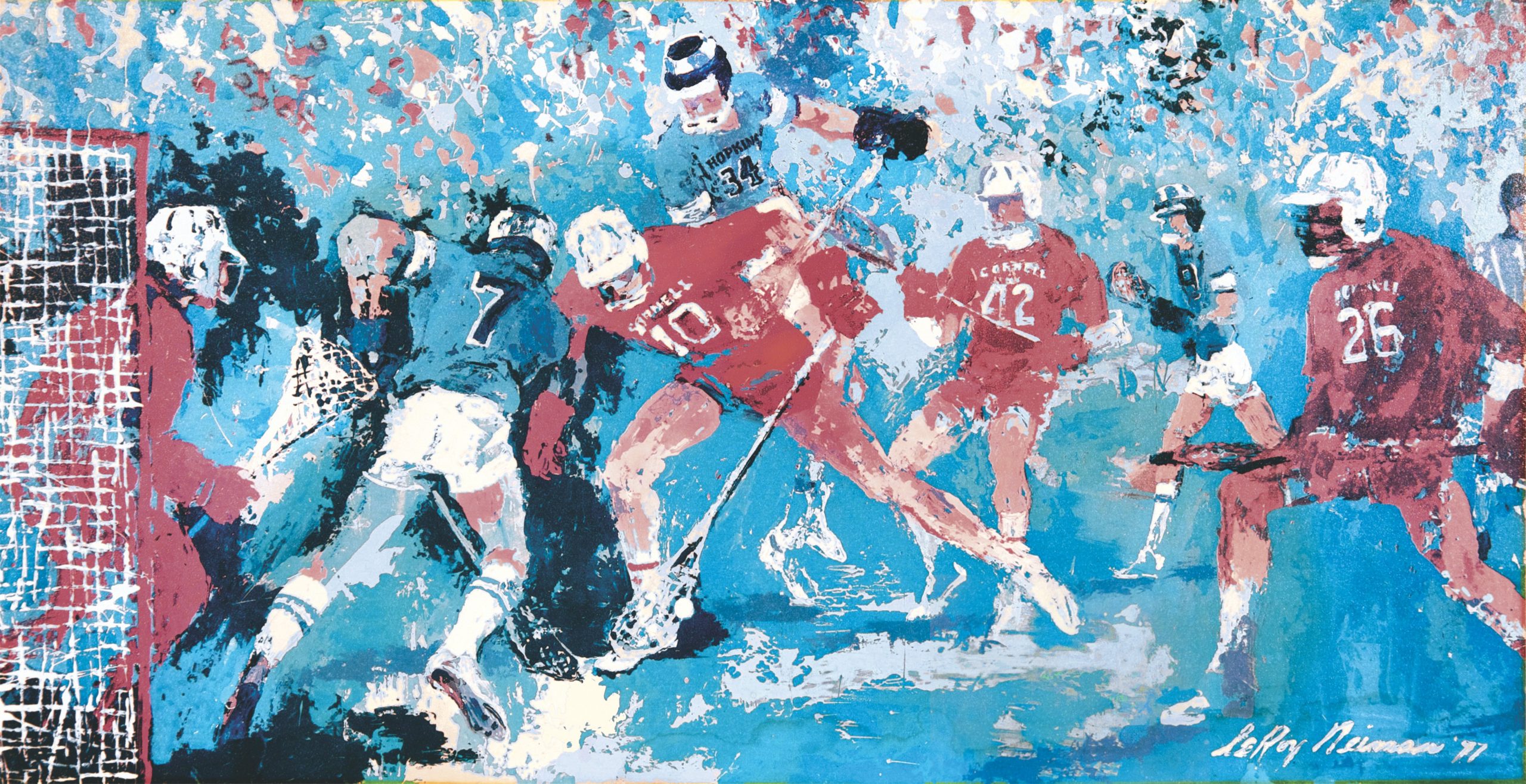
From Ron Demer ’59 – Sept. 2, 2023
I just ran across an article about Eamon which ends with mention of the Leroy Neiman lacrosse print (above). I donated a copy to SAE which now hangs in the library.
After his death, McEneaney’s family started a search to recover a painting artist Leroy Neiman completed after watching Cornell play Johns Hopkins as a guest of lacrosse alumnus Robert Rule. Neiman gave Rule the painting after his visit. The painting was found in the home of Bill Brine, one of the founders of Brine Lacrosse, who didn’t know the McEneaney family was looking for it. The painting features No. 10 in the center, with the ball, head down, driving to the goal through a wall of blue defenders.
“Eamon is often touted as the toughest Cornell athlete, pound for pound, that ever wore a Cornell jersey. I have never heard this reputation challenged,” said Cornell Athletic Director J. Andrew Noel.
— Suzanne Eschenbach
Suzanne and Neiman were wrong about saying that Eamon was driving thru the wall of Hopkins defenders towards the Hopkins goal. They show Eamon, an attack man, actually attacking the CORNELL goal. Also, the print shows Eamon #10 as a big guy; he actually weighed 160 pounds.
Rule and Neiman are deceased.
